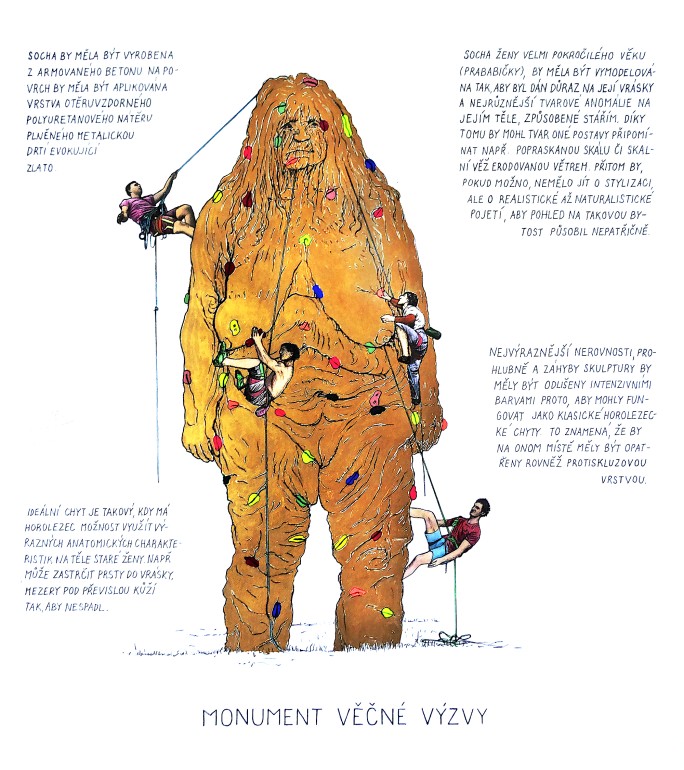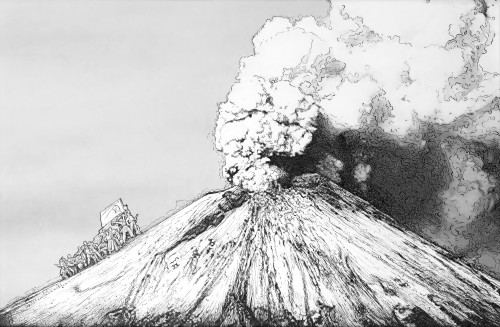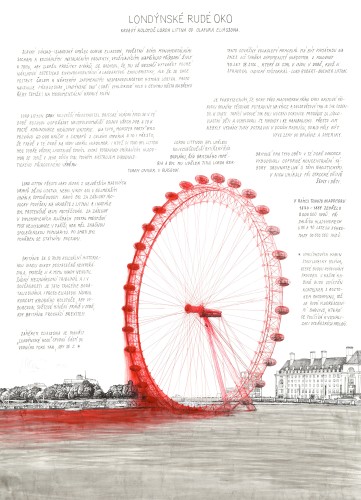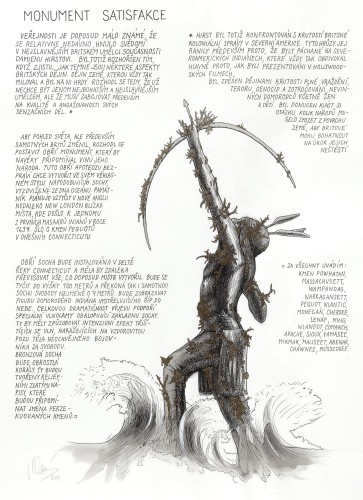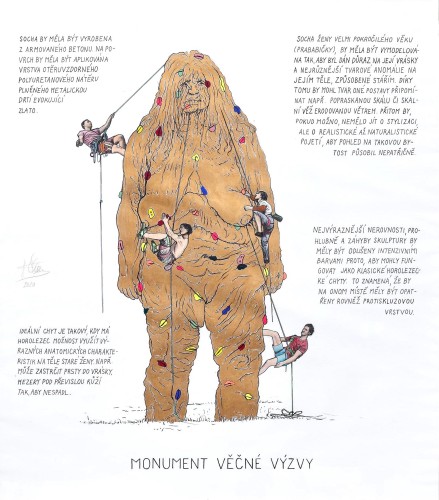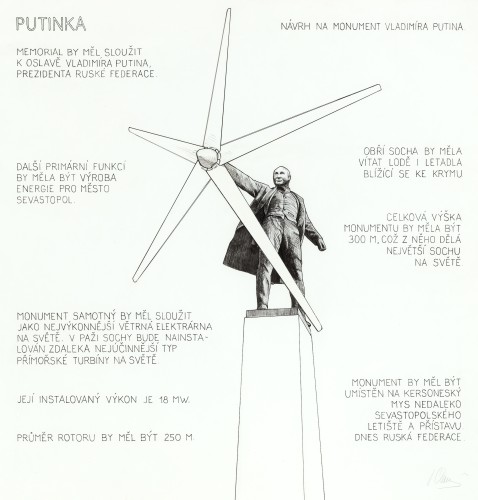Proposals for new locations of celebratory communist monuments on regional active volcanoes.
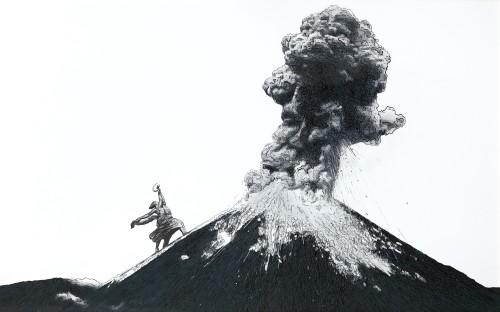
Proposal for the placement of the famous Moscow monument “Worker and Collective Farmer” by sculptor Vera Mukhina on the active Koryatskaya volcano in Kamchatka. 2018, 80 x 140 cm, pencil on paper.
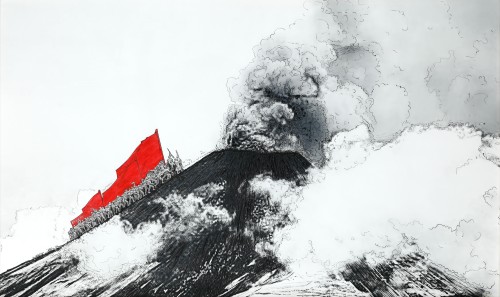
Proposal for the placement of the monument to the Anti-Japanese War and Socialist Revolution – “Mansude”, located on the sacred Mansu Hill in Pyongyang, on the Chungnyongsan volcano in North Korea. 2018, 80 x 140 cm, pencil on paper.
A proposal for the location of a war memorial, located in front of Mao’s Mausoleum in Tiananmen Square in Beijing, on the active volcano Wudalianchi in Manchuria. 2018, 80 x 140 cm, pencil on paper.
Proposal for the placement of a monument to Stalin by architect Jiří Štursa, his wife Vlasta, and sculptor Otakar Švec on the active volcano Karymskaya in Kamchatka, Russia. 2018, 80 x 140 cm, pencil on paper.
Designs by world-famous artists for monumental memorials re-evaluating the dark history of their countries
The latest project by star American artist Jeff Koons goes back to his own roots in the period when he created provocative pornographic works with the courtesan Cicciolina. In his more mature years, he discovered that art was not just about fame and raking in the money, but that it was actually possible to communicate through art the anguish that was weighing him down deep inside. It has to do with the injustice that is constantly covered up and downplayed in his country. It is about racism.
Recently, Koons got his hands on James Allen’s collection of photographs documenting racial violence in the American South at the turn of the 19th and 20th centuries, which he put together from family albums. Koons was shocked by the brutality of these images, and was furthermore appalled that these massacres of African Americans had been erased from U.S. history.
Often these are mass printed postcards that were produced as souvenirs and circulated throughout the United States. They depicted public lynches of black people – floggings, chopping off limbs, burning alive, but most importantly, thousands of images of African Americans being hanged, which were very popular in their day. Koons was especially frustrated by the crowds of white onlookers who chanted and enjoyed torturing the victims as if cheering at a football game.
And since he found that the white winning side maintained control over the history of racial violence, he decided to launch a campaign to remove the Statue of Liberty, which was a hypocritical mockery, and replace it with his own monument, Liberty Whore. The figure was to be naked, stylized after Cicciolina, but on top of that she was to have tattoos on her body such as those found in photographs in the James Allen Collection.
A tattoo design inspired by the murder of African-American Jesse Washington. He was beaten to death in front of 16,000 white men in 1916 in Waco, Texas. He was hanged from a tree by a chain and a fire was lit underneath him. His fingers were cut off so he could not climb up and he was castrated. He died from smoke inhalation.
London Red Eye
The renowned Danish-Icelandic artist Olafur Eliasson, famous for his monumental sculptures and large-scale installation projects using, for example, the elements of nature to enhance the viewers’ experience, has decided that it is no longer enough for him to create expensive aesthetic-environmental and land-art equilibrist art, but that he wants to confront some of the forgotten injustices of human history. He therefore proposed to convert the London Eye (a giant observation wheel in the center of the city on the banks of the River Thames) into a monumental blood mill.
This bold, spectacular memorial is intended to commemorate the now almost forgotten famine of the mid-1870s, which occurred in India when it was administered by the Indian Viceroy, Lord Robert Bulwer-Lytton.
At the time, this high-ranking British government official decided to throw the most lavish celebration of all time to mark the coronation of Queen Victoria. 60,000 princes and satraps from all over the empire were invited to this “monster party”, even though famine was striking India at the time. Although Lord Lytton was well aware of this, he refused to give food to the dying people because famine was in his eyes merely an instrument of Darwinian natural selection.
The absurdity is that years before the British had forced peasants to grow crops for export and the world market, thus condemning them to death. Famine stricken Indians were forced to sell even their own children for food, often resorting to cannibalism. Yet none of the tons of food stored on the docks in Madras, from where it was to be exported to Britain and America, was given to them.
The British built disgusting detention centers providing relief for the famine victims, comparable to the Nazi concentration camps. In them, women and young children died in slave labor. The famine of 1876–1878 caused the death of 8,000,000 Indians, in the subsequent famines of the 1880s and 1890s, a total of 30,000,000 Indians died.
Although Lord Robert Bulwer-Lytton was one of the greatest mass murderers in human history, he was never held accountable in the slightest. Ironically, he was instead created Earl of Lytton and continued to receive special protection. During his career in the Diplomatic Service he was appointed Ambassador to Paris, where he enjoyed considerable popularity and where, following his death, he was given a state funeral. He was awarded the Most Ancient and Most Noble Order of the Thistle and the Order of the British Empire. He also served as the Lord Rector of the University of Glasgow.
Britain has never adequately faced its colossal historical guilt because no international tribunal has forced it to do so. Even today, this tragedy is downplayed and not talked about. That is why Olafur Eliasson proposed the concept of a bloody merry-go-round to stir up world opinion at the very time when Britain is going through Brexit.
Monument of Satisfaction, 2020, 96 x 73 cm, ink and gold on paper.
It is little known to the public that relatively recently a conscience has stirred in the British most famous living artist Damien Hirst. He was outraged to discover how dark some aspects of British history were, the history of the country he had always loved and been so proud of. So he decided that he no longer wanted to be just the richest and most famous artist, but that he had to get better at the quality and engagement of his sensational works.
Hirst was confronted with the cruelty of the British colonial administration in North America. These horrors hurt him especially because they were perpetrated on the North American Indians, whom he had always admired so much, especially as they were presented in Hollywood films. He was horrified by the history of atrocities filled with murder, terror, genocides and enslavement of innocent Native Americans, including women and children. He was forced to wonder how many peoples had to disappear from the face of the earth so that the British could benefit from the misfortunes of others.
To change the view of the world, but above all of the British themselves, he has decided to build a giant monument that would forever commemorate his nation’s guilt. He wants to create this giant apotheosis of injustice in his famous style, imitating the statues raised from the bottom of the ocean. He plans to erect the monument in the region of New England near the city of New London, Connecticut, not far from the site of one of the first massacres of Indians in 1637 of the Pequot tribe.
The giant statue is to be installed in the delta of the Connecticut River and is supposed to surpass anything this great master has created to date. Its height will be 100 meters, exceeding the Statue of Liberty by at least 7 meters. It will consist of a figure of a Native American shooting an arrow into the sky. The overall drama of the scene will be enhanced by special breakwaters surrounding the base of the statue. These should produce an intense effect of rolling waves crashing against the defiant pose of the unwavering freedom fighter. The bronze statue will be covered by corals growing on it and decorated with embossed gold inscriptions, commemorating the names of the persecuted tribes, such as the following ones:
Pownatan, Massachusett, Wampanoag, Narrangansett, Pequot, Niantic, Mohegan, Cheroke, Lenap, Ming, Wiandot, Comanch, Apache, Sioux, Yamasee, Mikmak, Malisset, Abenak, Chawnee, Musscogee…
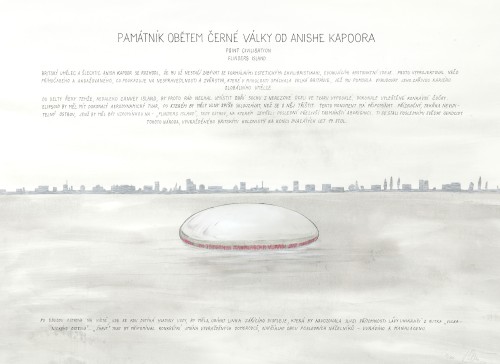
Memorial to the Victims of the Cold War by Anish Kapoor, 2020, 73 x 96 cm, pencil and crayon on paper.
Point Civilisation, Flinders Island
The British sculptor Sir Anish Capoor decided that it was no longer enough for him to engage in formal aesthetic equilibrist art, evoking abstract ideas. He therefore designed a straightforward and engaging work that highlights the injustices and atrocities perpetrated by Britain in the past, which helped him build a glittering career as a successful global artist.
He would like to place a giant stainless steel sculpture in the shape of a convex, perfectly polished concave lens in the Thames Delta near Canvey Island. This ellipsoid would have a perfect aerodynamic shape, on which the waves would glide rather than crash. This grand monument would represent a ghostly, almost invisible island, reminiscent of Flinders Island, where the last surviving Tasmanian Aborigines died. They were the last witnesses to the genocide of this nation, slaughtered by British colonialists in the late 1820s.
A glowing line on display would run around the perimeter of the island where the metal touches the water surface, giving the illusion of lava escaping from the interior of the “volcanically active” island. The “glowing” text would contain the specific names of the slaughtered natives, such as the last two chiefs, Woureddy [Wurati] and Mannalargenna [Manalakina].
Designs for common monuments
A statue of a very old naked woman should be sculpted with an emphasis on her wrinkles and the various shape anomalies on her body caused by old age. In this way, the form of the figure could resemble, for example, a cracked rock or a rock tower eroded by the wind. If possible, this should not be a stylization, but a realistic conception, so that such a creature is a quite appalling sight.The statue should be made of gilded reinforced concrete.
Significant irregularities in the sculpture should be distinguished by color so that they can function as artificial climbing holds. This means that they should be provided with an anti-slip coating at the appropriate place. Where the anatomy does not allow for the application of a hold, a classic hold can exceptionally be mounted on a smooth surface.
The ideal application of a hold is one where the climber can, for example, tuck his fingers into the wrinkle so that he does not fall down.
Putinka, a proposal for a giant monument that also serves as the most powerful wind power plant in the world, 2020, 80 x 79, pencil on paper.
